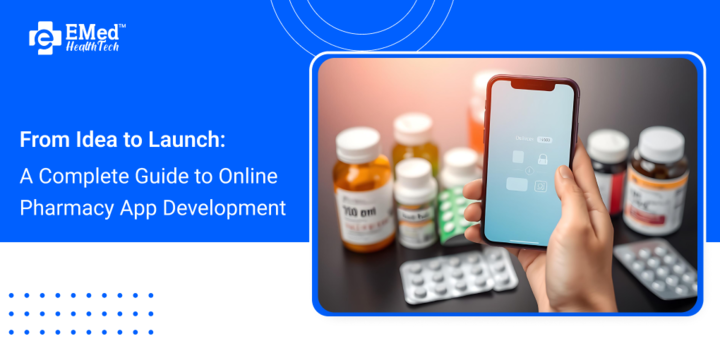Notifications

6 minutes, 36 seconds
-8 Views 0 Comments 0 Likes 0 Reviews

The healthcare industry is undergoing a digital transformation, and online pharmacies are becoming an essential part of modern healthcare services. With rising demand for convenient and contactless medication access, developing an Online Pharmacy App can be a game-changer for your business.
This comprehensive guide walks you through the entire Online Pharmacy App Development process—from idea to launch—helping you understand key features, development steps, compliance requirements, and how to succeed in the competitive digital healthcare space.
1. Understanding the Need for an Online Pharmacy App
Why Invest in an Online Pharmacy App?
Convenience for Customers: Allows users to order medications from the comfort of their homes.
Increased Revenue Potential: 24/7 accessibility leads to more sales opportunities.
Wider Customer Reach: Serve patients beyond physical store limitations.
Improved Medication Adherence: Automated reminders help patients follow prescriptions.
Market Growth and Trends
The global online pharmacy market is expected to grow at a CAGR of 16.8% from 2023 to 2030.
The COVID-19 pandemic accelerated digital healthcare adoption, making online pharmacy services more relevant than ever.
2. Planning Your Online Pharmacy App
Identifying Your Business Model
Before developing your app, define your business model:
Standalone Pharmacy App: If you own a single pharmacy, an app can allow direct sales to customers.
Pharmacy Marketplace: A platform where multiple pharmacies list their medicines and compete.
Telemedicine Integration: Combine online consultations with prescription fulfilment.
Subscription-Based Model: Offer regular medication refills for chronic disease patients.
Competitor Research & Target Audience
Identify competitor strengths and weaknesses to position your app effectively.
Define your target users—elderly patients, chronic illness patients, or urban users looking for convenience.
3. Key Features of an Online Pharmacy App
A successful pharmacy app should offer user-friendly navigation, security, and seamless integration.
For Customers:
Easy Registration & Profile Management – Simple sign-up via email or phone number.
Medicine Search & Filters – Find medicines by name, category, or symptoms.
Prescription Upload – Allow users to upload doctor prescriptions for verification.
Order Tracking & Delivery – Live order updates and estimated delivery time.
Automated Refill Reminders – Alerts for prescription refills.
Secure Payment Gateway – Integration with multiple payment options.
For Pharmacies & Admins:
Inventory & Stock Management – Real-time tracking of available medicines.
Order Management – View, process, and fulfil orders efficiently.
Analytics & Reporting – Monitor sales, revenue, and customer behaviour.
Multi-Pharmacy Support – Manage multiple pharmacies under one system.
4. Technology Stack for Online Pharmacy App Development
Choosing the right technology stack ensures performance, scalability, and security.
Front-End Technologies (User Interface):
Flutter or React Native – For cross-platform mobile app development.
Angular or React.js – For a responsive web interface.
Back-End Technologies (Server & Database):
Node.js or Python (Django/Flask) – For handling back-end logic.
MongoDB or MySQL – For secure and scalable database management.
Security & Compliance:
HIPAA & GDPR Compliance – To protect patient data and privacy.
SSL Encryption – To secure transactions and data transfers.
5. Development Process: From Idea to Launch
Step 1: Requirement Gathering & Research
Define core features based on market research.
Identify potential challenges and solutions before development starts.
Step 2: UI/UX Design
Create wireframes for user-friendly navigation.
Ensure the app is mobile-responsive for better accessibility.
Step 3: Development & API Integration
Develop the front-end and back-end simultaneously.
Integrate payment gateways, GPS tracking, and inventory APIs.
Step 4: Testing & Quality Assurance
Perform unit testing, performance testing, and security checks.
Fix bugs before the official launch.
Step 5: Deployment & Launch
Publish the app on Google Play Store & Apple App Store.
Ensure smooth onboarding with tutorials and customer support.
6. Ensuring Legal Compliance & Security
Regulatory Compliance Based on Location
USA: Must comply with HIPAA (Health Insurance Portability and Accountability Act).
Europe: Follow GDPR (General Data Protection Regulation).
India: Comply with CDSCO (Central Drugs Standard Control Organization).
Data Security Measures
End-to-End Encryption: Protects transactions and sensitive patient data.
Two-Factor Authentication (2FA): Enhances login security.
Secure Cloud Storage: Safeguards electronic prescriptions and health records.
7. Post-Launch Strategy & Marketing
App Promotion & User Acquisition
SEO & App Store Optimization (ASO): Improve visibility in searches.
Social Media & Digital Marketing: Use targeted ads to attract users.
Referral & Loyalty Programs: Encourage users to invite others.
Customer Support & Continuous Updates
24/7 Support & Chatbot Integration – Instant responses to customer queries.
Regular Feature Updates – Add new functionalities based on user feedback.
Conclusion: Launch Your Online Pharmacy App Today!
Developing an Online Pharmacy App is a smart investment in the digital healthcare revolution. From selecting the right business model to integrating essential features, the success of your app depends on careful planning, compliance, and user-friendly design.
Ready to build your online pharmacy? Partner with emedhealthtech.com for custom app development and launch a secure, scalable, and feature-rich pharmacy app today!
#healthcare emedhealthtech onlinepharmacyapp ePharmacyapp pharmacyapp onlinepharmacy

